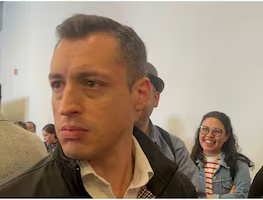Más Información

ONGs piden a Sheinbaum contemplar propuestas para seguridad vial; más de 16 mil personas mueren por accidentes

De la Fuente se reúne con representantes de 9 países de América Latina; coordinan acciones de migración

Mexicanos en EU entregan a SRE propuestas para defensa de los migrantes; destacan derechos de las mujeres

Colosio critica comités de evaluación de elección judicial; oficialismo escogerá a sus candidatos, acusa
ANDREW SELEE *
During the last 14 weeks, the most popular song in the United States has been Despacito , a version of the catchy song by Luis Fonsi and Daddy Yanqu i with some English lyrics by Canadian Justin Bieber .
Two more weeks and it would be the most popular song of all time in the rankings of American pop music, a surprising fact considering it is a song in Spanish and Latin rhythm. Everything seems to indicate that Latino culture is increasingly becoming part of the American social fabric.
During the last eight years, the president of the United States was Barack Obama , son of a white mother and African and Muslim father. Today, President Donald Trump is advised in the White House by his daughter Ivanka and his son-in-law Jared Kushner, both Orthodox Jews, who do not work on Saturdays in observance of their religious beliefs. There are two governors-both Republicans-of Mexican descent and one of Hindu descent.
Perhaps, it is not a coincidence that when the religious and ethnic diversity of the United States is becoming more evident, more openly racist and neo-Nazi groups emerge strongly, claiming white Christian superiority and seeking to overturn the growing plurality of the country. There has been an unstoppable trajectory toward the inclusion of new groups in the country's politics, culture and economy, which also threatens those who once considered themselves the privileged group.
Last week, in Charlottesville , Virginia , these groups had a more open and crowded public parade that ended up in fights with protesters who rejected their hate speech . One of the extremists used his car to attack the protesters, injuring several people and killing a young woman.
These racist groups are not new. In fact, it is a cycle that has been repeated in American history over and over again. In the years leading to the Civil War , in the 1850s , an anti-immigrant and anti-Catholic party colloquially known as the " Know-Nothings "- those who know nothing, a name they coined themselves-was created.
In the post-Civil War period , when the slaves were liberated, the Ku Klux Klan emerged. It was a white supremacist group that sought-and succeeded across southern United States -to impose racial restraints on who could participate in politics, get married and have business and homes in the white areas of cities.
With the Civil Rights Movement , in the 1950s and 1960s , these groups resurged to oppose social and political inclusion, and they have continued as a silent but persistent presence in the American social field. In the recent anti-immigrant movements, these groups have had a little visible but no less real presence, worried about the arrival of Mexicans and other immigrants to the country.
Rhetoric refugees
It is not surprising-yet regrettable and condemnable-that racist groups emerge in times of rapid demographic and political change.
Commenting on the events in Charlottesville, a normally quiet town two hours away from Washington, Trump seemed to condemn both the white extremists who paraded around the city denouncing African-Americans, immigrants, Jews, and Muslims, as well as protesters who supported social inclusion in the United States.
Trump resurfaced a couple of days later, to plead for tolerance, but then condemned the two sides again.
While Trump has never given his approval to these extremist groups, since the presidential campaign he has sometimes sent subtle signals of his consent, if not support, for them. And these groups, of course, feel strongly reinforced since the elections, as Trump has emphasized limiting migration from Muslim countries, deporting immigrants and building a wall between Mexico and the United States, issues that have always been in the extremists' agenda.
I doubt that Trump really supports these groups and it would not be true to say that his agenda is the same as theirs. What is certain is that Trump understands and sometimes channels and legitimizes the fears of an American white sector that feel that it is losing control in an increasingly plural and diverse society. The country they remember is no longer the country in which they grew up. They are living in an era in which their neighbors-and their political representatives-are of many different colors and religions, and the song they hear over and over again on their children's radio is Despacito , with its Latin rhythm and its lyrics in Spanish.
The question remains on the air for President Trump. While he can understand and sympathize with the fears of a particular segment of the population, does he want to be the President of that particular group or does he want to be the President of a country that stands out for its growing plurality and diversity?
* President of the Migration Policy Institute and former director of the Mexico Institute of the Wilson Center
sg






